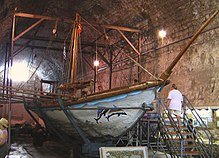Minoa (ship)
Minoa ( Greek Μινώα ( f. Sg. )) Is the name of the seaworthy replica of a Minoan rowing ship from the 15th century BC. Chr., Which was built from 2001 to 2004 under the leadership of the Naudomo research team and the Nautical Museum in Chania on Crete . In the construction, techniques and materials were used that were available in the Bronze Age . In 2004 the Minoa went to Piraeus for the Olympic Games in Athens and was shown there in an exhibition of reconstructed ancient ships.
The reconstruction
The aim was the realistic reconstruction of a rowing ship from the 15th century BC. And the documentation of the process. Since there were no finds of shipwrecks from this period, an approach based on archaeological research was chosen that included images, knowledge of the raw materials and materials available at the time, as well as technologies and basic rules of shipbuilding. The ship was to be 17 meters long and 4 meters wide, a rowing boat made of cypress trunks connected with ropes and with a simple rectangular auxiliary sail.
Preliminary studies
First, a three-dimensional digital version was created, from which conclusions for the construction process could be drawn. Then a 1: 5 scale model was built from five meter long cypress trunks to simulate the entire construction process. The results of these preliminary studies were presented at a scientific congress.
At the end of 2002, production began in the Venetian shipyard in the eastern part of the port of Chania. In addition to the Naudomo Institute and the Nautical Museum of Chania, experienced carpenters from Chania participated in the construction.
construction
The keel consists of a 22-meter-long cypress trunk, both ends of which have been bent upwards by pulling a cable and applying heat. On both sides of the keel, logs that were cut in half lengthwise were laid out, pierced and lashed together with ropes, forming a kind of raft. With pulley blocks they were pulled up into a semi-cylindrical shape and tied up.
A mixture of beef fat and resin was produced for the sealing, the mixing ratio of which was found out experimentally. Using a traditional caulking method , the gaps between the unsanded trunks were filled with ropes soaked with the mixture. The entire hull was then sealed with the same mixture and a white fabric impregnated with the same mixture was applied over it, which was later decorated with drawings in the Minoan style.
The gunwale , the longitudinal bandage, consists of two polished cypress trunks and is shaped like an "A", the tip of which forms the bow. The two ends of the "A" protrude beyond the stern and have been drawn together gradually.
Benches were then attached for eleven pairs of oars, the gangway and a bridge in the middle of the ship, which also houses the sail when the ship is not at sea. An open cabin was built at the stern and the sail mast in the middle of the ship.
The Minoa at sea
The launch took place on December 1, 2003 in the presence of the Greek President. From May 29th to June 24th the Minoa drove from Chania via Andikythira , Kythira , Monemvasia , Kyparissi , Spetses , Ydra , Poros , Methana and Aegina to Piraeus. She covered 210 nautical miles in 10 day trips . The average speed with oars and sails was 3.2 knots , with oars alone 2.3 knots. She covered 90% of the distance by oar drive alone.
The Minoa brought olive branches to Piraeus to honor the winners of the marathon run at the Olympic Games. The ship belonged together with the Eleftheria , a replica of the Kyrenia ship, to the escort of the Athenian trireme Olympias , which brought the Olympic flame to Piraeus. The three ships could then be viewed in the port of Piraeus during the Olympic Games.
exhibition
The Minoa and documentation of the construction process can be seen in the Sabbionara Bastion at the port of Chania as a permanent exhibition. The ship is kept seaworthy so that it can take part in suitable events, whereby it should be able to make the way to sea itself over short distances.
Individual evidence
- ↑ Information from Maritime Museum of Crete (ed.): The Minoa Ship . Chania no year
Web links
- Thomas Guttandin, Diamantis Panagiotopoulos, Gerhard Plath: The islands of the winds. Experimental archeology lets Minos' fleet sail again. Heidelberg University, October 4, 2010, accessed February 25, 2014 .
- Archaeologists let Minos' fleet sail again. The "Islands of the Winds" project reconstructs the maritime development of Minoan Crete. scinexx, accessed February 25, 2014 .


